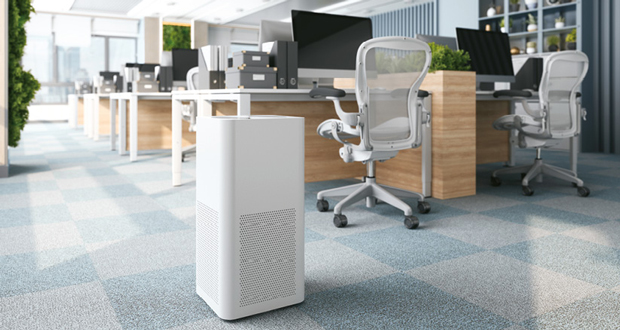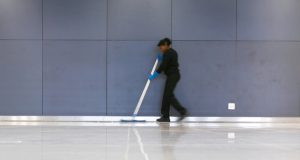Christian Hendriksen, Co-Founder & CEO, Rensair on research that suggests the benefits of balancing mechanical ventilation with in-room air purification systems
Worsening air pollution, combined with the global pandemic, is driving new government regulation to substantially improve indoor air quality.
However, while ventilation is key to protecting respiratory health, it also demands more energy. A typical HVAC system can already account for half a building’s total energy consumption, as fresh air intake needs heating in winter and cooling in summer.
Stricter legislative standards will require far higher levels of ventilation, such that spiralling energy costs may pose a real threat to the bottom line.
The Clean Air (Human Rights) Bill, tabled by Green party peer Baroness Jenny Jones, has had its second reading at the House of Lords. If made law, it would tackle all forms of air pollution, both indoor and outdoor, and involve the UK Health Security Agency in setting and reviewing pollutants and their limits.
The initiative goes hand in hand with the latest Indoor Air Quality (IAQ) report from the National Engineering Policy Centre (NEPC). Commissioned by Government Chief Scientific Adviser Sir Patrick Vallance, with a foreword by England Chief Medical Officer Professor Chris Whitty, the report calls for a radical reform of ventilation and infection resilience across all buildings and public transport, with a heavy emphasis on IAQ standards being set, monitored and regulated.
INCREASED VENTILATION
While many will welcome the tightening of clean air regulations as overdue, businesses may not be so keen. That’s not only because upgrades to integrated Heating, Ventilation and Air Conditioning (HVAC) systems are expensive, but because energy costs have never been higher and are threatening to cripple companies across many different sectors.
According to the World Economic Forum, buildings are responsible for 40 per cent of global energy consumption. A typical HVAC system can account for half a building’s total space-conditioning energy consumption. That’s because mechanical ventilation introduces outside air into a building, which needs to be conditioned to a constant temperature to ensure a comfortable indoor environment. To achieve the desired temperature, typically around 21C, requires either cooling and dehumidifying through Air Handling Units (AHUs) or heating in the winter, via radiators or AHUs.
Given current pricing, the impact of a sharp rise in energy consumption is substantial. It also has a negative impact on carbon emissions. Residential and commercial building sectors are responsible for 33 per cent of global greenhouse gas emissions, so they have a big part to play in realising the UK government’s net zero target by 2050.
DISRUPTIVE SOLUTION
In July/August 2022, air purification specialist Rensair conducted proprietary research to consider the potential for maintaining good indoor air quality, without incurring extra energy costs.
The premise of the research was that the World Health Organisation’s recommended clean air delivery rate for offices and other shared public spaces must be maintained at 10 litres per second per person (l/s/p) – along with a maximum CO2 level of 1,000ppm, which is lower than the UK HSE’s recommended maximum level of 1,500ppm.
The findings confirmed that the optimum levels of clean air and CO2 can be achieved by dynamically balancing traditional mechanical ventilation with in-room air purification devices. The result of striking the right balance was shown to unlock energy savings upwards of 40 per cent.
With today’s escalating energy prices, such consumption savings translate into substantial financial savings. After the much-publicised recent hike in energy costs, Ofgem expects further sharp increases from October, with electricity rising by another 20 per cent and gas by 40 per cent. With operations and facilities functions under pressure to cut costs, air purification demands closer inspection.
CLEAR BENEFITS
On 28 July 2022, the UN General Assembly adopted a historic resolution declaring access to a clean, healthy and sustainable environment as a universal human right. It’s also just come to light that exposure to air pollution may be the root cause of lung cancer, with other new research warning of the link between airborne microplastics and cancer. It stands to reason that regulation will soon be put in place to better protect people in shared spaces.
While ethics and regulation cannot be ignored, the commercial drivers for businesses to improve indoor air quality are arguably even stronger. A recent new study from Harvard University shows that there is a direct relationship between the amount of fine particulate matter in the air and how people perform in mental tests. The cleaner the air, the better people perform. In short, clean air means better concentration, information retention and productivity, combined with lower absenteeism. Any business would gladly pay good money for such benefits.
Air purification as a solution for indoor air quality adds yet further tangible financial gain, through substantial energy savings that deliver immediate payback. For buildings that don’t have any HVAC, portable air purifiers are a fraction of the capex cost of a modern integrated HVAC system and therefore a practical ‘plug & play’ solution for office retrofits.
Today, fresh thinking on clean air should be on every business agenda and should include air purification. After all, which company wouldn’t want to improve their triple bottom line: people, profit and planet?





